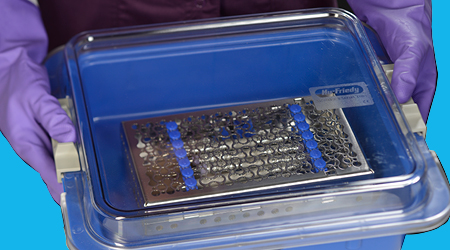

If your instruments are being handled during reprocessing, your staff is being put at risk unnecessarily. Sharps injuries can lead to exposure to infections such as hepatitis B, hepatitis C, and HIV. These injuries also carry a significant cost. Between the time off, medical testing, and insurance, post-exposure management costs a practice up to $3,000 per incident. ¹
But the solution is simple. Limit the number of touches to eliminate the risk. Our Instrument Management System (IMS™) cassettes keep your instruments secured and safe throughout reprocessing, so you only need to touch them when you use them. Learn about the impact: IMS eliminated sharps injuries at Pacific Dental Services™ while delivering a significant return on investment.

CDC recommends all items to be sterilized should be packaged using an FDA cleared container system or wrap that is compatible with the sterilization process used. The sterile instruments and supplies should then be stored in a covered or closed cabinets. Do not sure under sinks or in places where they could become wet. Be sure to inspect wrapped packages before opening to ensure the packaging is not wet, torn, punctured, or otherwise compromised.
CDC Guidelines recommend various types of chemical indicators (CI) including the use of “external” and “internal” chemical indicators stating that a type 1 CI be placed on the outside of each instrument package, unless the internal CI is visible from the outside.” CDC Guidelines also address “single-parameter” and “multi-parameter” chemical indicators as they provide a more reliable indication that sterilization conditions have been met. Yet, there are not specific recommendations for the use of these specialty indicators within the Guidelines. The manufacturer’s instructions for use of the chemical indicator will indicate the sterilizer type and cycle in which the CI should be used, placement within the package, storage, expiration date, and how to interpret the exposed CI.
Routine sterilizer efficacy monitoring is a critical element of your practice’s infection prevention and control protocol. Steam sterilization is, of course, a routine part of instrument reprocessing, and it’s important to ensure your sterilizer is functioning properly for every load. As a result, there are certain steps you should be taking monthly, daily, and per each load to achieve sterility assurance. To achieve best practices, in-office biological monitoring should be done daily (or at a minimum at least weekly).
It's nearly impossible to count all the opportunities to potentially spread infection between patient to practitioner, practitioner to patient, or patient to patient in the dental office. Single use disposable items are a large part of an office’s infection prevention practice. Single Use Operatory Supplies cover a wide range of products you need - such as barrier protection, patient towels & bibs, cups cotton/non-wovens, tongue depressors and x-ray products.